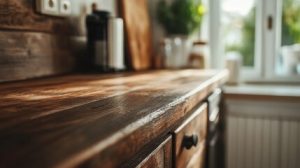A skilled San Jose Cabinet Refinishing expert can help you achieve the look you desire, whether you want rustic charm or a modern look. They have a deep understanding of painting products and processes, including sanding, cleaning, and applying primers to promote durability and smooth coatings that last.
Begin by scuff-sanding the cabinetry to improve paint adhesion. Use a quality wood filler to patch any areas that are damaged and sand again to create a smooth surface.

Sanding
Whether your cabinets are decades old or fresh off the showroom floor, they’ll need to be prepared for paint to adhere to them. That prep work includes cleaning and sanding the existing surfaces to create a smooth, even surface. It’s an important step that can save you from a shoddy finish. Here’s how to get it right.
Before you can begin the sanding process, you’ll need to remove any existing finishes. This will likely involve a chemical stripper, which you’ll want to apply in a well-ventilated area with a mask. It may take up to 24 hours for the stripper to break down the existing stain or paint. After the surface has been stripped, it will need to be washed and wiped down with a degreaser or TSP (trisodium phosphate). This will help ensure that any remaining grime is broken down and removed, so the new primer and paint will adhere correctly.
When it comes to sanding, many homeowners assume they have to remove all of the sheen to create an even surface. However, that’s not necessarily true. You can sand down the surface to roughen it, but you should always use a fine-grit sandpaper and be careful not to gouge or scratch your cabinet doors. A block sander gives you more control, so it’s a good idea to use one for this step.
After sanding, you should vacuum and tack your cabinets to clear away any dust particles. This will also help prepare them for priming. You’ll want to use a shop vac or brush attachment, as well as a tack cloth, to remove any remaining dust. Using a tack cloth will also help you spot any areas that need further attention.
Before you begin sanding, it’s important to remove any hardware from your cabinet doors and drawer fronts. This will prevent you from accidentally damaging them or pulling the screws out of the hinges. It’s also a good idea to label each door and drawer with a piece of tape. This will make it easier to replace them when you’re finished.
Cleaning
Professionals know how to properly clean surfaces for a smooth, streak-free finish that will last. They also have the expertise to choose the best color and stain to meet their client’s design goals. This attention to detail sets them apart from DIY projects and ensures long-lasting, quality results that will enhance the value of your home.
Cabinets must be completely cleaned before being painted or refinished. This is the only way to ensure that the new coating will adhere to the surface and last for years to come. Start by removing the doors and drawers, then use a mild degreaser to wash the interiors and exteriors of the cabinets. Be sure to wash down the hinges and hardware, too. If there are any cracks or holes in the cabinetry, fill them with wood filler and sand them smooth before moving on.
Next, you’ll need to prepare the cabinetry for painting or re-staining by sanding and priming. Depending on the material, a high-quality latex primer is typically recommended. If your cabinets are stained, a stain-blocking primer is important to help the new coat of paint or stain adhere better and last longer.
Finally, you’ll need to prime the entire cabinetry, including the inside of the boxes, if they’re going to be painted. This step will help the new finish seal better and prevent moisture from damaging the wood or chipping the existing finish.
Once the cabinetry has been thoroughly sanded and prepared, it’s time to start with the fun part – painting or re-staining! Choose a color that complements the rest of your kitchen, and don’t forget to apply a clear protective coat to shield the finish from moisture and scratches.
This will protect the finish and add a nice, glossy shine to your cabinets. Be sure to follow the manufacturer’s instructions for application and drying times. When finished, your cabinets will look brand new and fresh! Enjoy your beautiful new kitchen!
Primer
If your cabinets are glossy or made from laminate, they’re difficult for paint to stick to without proper prep. Sanding alone won’t do the trick; you need a product to create a solid bond between your surface and new paint. It’s like giving the paint a firm handshake to make sure it stays put and won’t flake off with the slightest touch.
In addition to creating adhesion, a quality primer also fills in small dings and cracks, making your cabinet surface smooth for painting. It’s an extra step that helps ensure a professional finish for your cabinets, which are often a key selling point for homes.
If you’re using an oil-based primer, it’ll also seal and block stains on the cabinetry, including tannins, which can leak through your paint job if not sealed properly. This is especially important if you’re painting knotty wood or oak cabinets.
Tinted primer also cuts down on the number of paint coats needed, reducing costs and time spent on your project. Ask your local paint store for help finding a tinted primer that matches your chosen cabinet color.
When applying primer and paint, it’s important to follow the directions on the can. It’s crucial to let each coat dry completely before moving on, and to allow plenty of time for the finished product to cure and harden.
It’s also important to label the hardware on each cabinet and to mark the locations of each door or drawer so that they can be reattached with ease later. Finally, be sure to protect backsplashes and appliances with plastic or tape. Taking the extra time up front will save you a lot of headaches down the road. By following these tips, you can have beautiful, updated kitchen cabinets that will stand up to years of wear and tear in your home. Finishes are formulated to resist damage from cooking oils, grease, moisture, and high heat, so they’ll keep looking fresh and beautiful long after you’ve moved in. For the best results, use a quality primer, paint, and topcoat that are designed to withstand kitchen environments.
Paint
Professionals use superior materials and precise techniques to achieve smooth coatings that withstand normal wear and tear. This attention to detail minimizes peeling and chipping over time, enhancing the longevity of your kitchen cabinets. Whether your design goal is rustic charm or sleek modern appeal, skilled artisans will produce a finish that meets your vision and complements your home’s other elements.
To get the best results, your cabinetry must be clean and dry before you paint. A thorough cleaning with a degreaser like trisodium phosphate (TSP) or a mild dish soap will remove any food residue and oil buildup, ensuring your new finish adheres correctly. Once the surfaces have been cleaned, a light sanding is recommended to remove any bumps or grooves that were created during your previous finish and to give the surface “tooth.” After sanding, a vacuum or a tack cloth should be used to remove any dust particles.
A good quality wood primer is essential to ensure that your new finish will stick to the existing material. It is important to apply the primer in a well-ventilated area, according to the product’s instructions. A high-quality oil-based primer is preferred as it provides durable protection for your cabinets.
Before you begin painting, it is important to label all of your doors and cabinet frames. This will help you keep track of each piece during the refinishing process and make sure they are all reinstalled in the proper order. It is also a good idea to number the cabinet openings and door fronts so you can easily match them up when it comes time to reinstall them.
Most how-tos for painting cabinets will suggest using a small, smooth roller or a high-quality brush to get the best result. However, professional painters have access to tools that can help them achieve an even more uniform look with less effort. In addition, they know all the tips and tricks for getting a smooth result on hardwood trim pieces, such as baseboards and window sills.
Choosing the right color to paint your cabinets can be tricky and is an important aspect of the refinishing process. A skilled painter will be able to create a custom shade that perfectly matches your other colors in the kitchen and coordinates with any other elements in your space.
